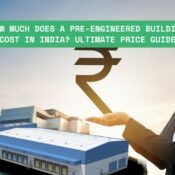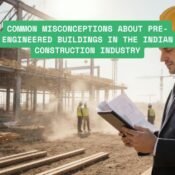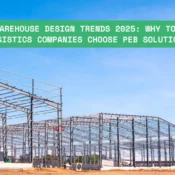
How Pre-Engineered Buildings are Revolutionizing Commercial Construction?
A Wake-Up Call for Business Owners
A few years ago, a thriving logistics business found itself at a crossroads. The company had been expanding rapidly, and with increasing demand, their rented warehouses could no longer keep up. They needed a bigger space fast. Traditional construction was out of the question; the costs were skyrocketing, and waiting over a year for completion wasn’t an option.
The owner, frustrated by delays and budget overruns, started looking for alternatives. That’s when they stumbled upon Pre-Engineered Buildings (PEBs) a game-changer that transformed their expansion plans. Within months, a state-of-the-art facility was up and running, saving them nearly 40% in construction costs and shaving months off the project timeline.
This story isn’t unique. Across industries—whether manufacturing, warehousing, or retail businesses are facing the same challenges: rising construction costs, labor shortages, and unpredictable delays. But those who turn to PEB structures are discovering an efficient, cost-effective, and sustainable way to scale.
So, what exactly are Pre-Engineered Buildings, and why are they revolutionizing commercial construction? Let’s break it down.
What Are Pre-Engineered Buildings (PEBs)?
A Pre-Engineered Building (PEB) is a structure designed, fabricated, and assembled using pre-manufactured components, primarily steel frames, wall panels, and roofing systems. Unlike traditional brick-and-mortar construction, where everything is built from scratch on-site, PEBs are manufactured in a controlled factory environment and then assembled like a giant puzzle at the project location.
This method speeds up construction, reduces waste, and ensures consistent quality—qualities that traditional construction methods struggle to match.
Why Businesses Are Ditching Traditional Construction for PEBs
1. Faster Construction – Time is Money
Time is a critical factor in commercial projects. Every day of delay means lost revenue, increased holding costs, and missed opportunities.
Traditional construction projects can take anywhere from 12 to 24 months, depending on complexity. Factors like weather conditions, labor availability, and material delays often stretch timelines even further.
In contrast, PEB structures can be erected in as little as 6 to 12 weeks. Since most components are pre-fabricated, site work and installation happen simultaneously, dramatically reducing construction time.
🔹 Real-World Impact: A manufacturing unit needed to expand operations to meet a sudden surge in demand. A conventional building would have taken 18 months. By choosing a PEB solution, they had a fully functional production facility in just four months—meeting deadlines and boosting revenue.
2. Cost-Effective Solutions – Save Up to 40%
Construction costs aren’t just about raw materials. Labor, transportation, site management, and unforeseen delays can significantly inflate expenses.
PEBs help businesses save in multiple ways:
✅ Lower Material Costs – Bulk manufacturing of components reduces expenses.
✅ Reduced Labor Costs – Faster construction requires fewer labor hours.
✅ Minimal Maintenance – Steel structures are resistant to termites, weather damage, and corrosion, reducing long-term upkeep costs.
🔹 Case in Point: A retail chain looking to build multiple outlets found that PEB structures cost 30-40% less than traditional methods. The savings enabled them to expand into more locations, increasing overall profitability.
3. Design Flexibility – Build It Your Way
Unlike the rigid nature of conventional buildings, PEBs offer immense flexibility in design. Whether you need:
✔️ Wide clear spans for warehouse or manufacturing floors
✔️ Multi-story configurations for office spaces
✔️ Custom architectural finishes for a sleek, modern look
PEBs can be tailored to specific industry needs without compromising strength or durability.
🔹 Example: A logistics hub required a warehouse with column-free space for easy vehicle movement. A PEB solution provided a clear span of over 100 feet, something that would have been expensive and challenging with conventional structures.
4. Sustainability – Building a Greener Future
With industries moving toward eco-friendly solutions, PEBs stand out as a sustainable choice. Here’s why:
🌱 Less Waste – Since components are pre-fabricated, material wastage is significantly reduced.
⚡ Energy Efficiency – Insulated panels and cool roofing options lower energy consumption.
♻ Recyclability – Steel, the primary material in PEBs, is 100% recyclable.
🔹 A Green Example: A cold storage company integrated solar panels on a PEB warehouse roof, reducing electricity costs by upto 60% while maintaining an eco-friendly footprint.
5. Strength and Durability – Built to Last
PEBs aren’t just quick and cost-effective; they’re built to withstand harsh conditions. These structures are designed to resist:
🌀 Strong Winds – Perfect for storm-prone regions
🔥 Fire Hazards – Steel doesn’t catch fire like wood
🌧 Heavy Rain & Snow Loads – Engineered for extreme weather
🔹 Industry Insight: A steel fabrication unit opted for a PEB factory shed in an area with frequent storms. The high-tensile steel framework provided better resistance to strong winds compared to conventional concrete buildings.
"At Metal Tree, we believe the future of construction is smarter, faster, and more efficient. Pre-engineered buildings are not just a cost-effective alternative they are a revolution in commercial infrastructure. By combining innovation with durability, we help businesses scale without the setbacks of traditional construction. Build faster, build stronger, build with Metal Tree."
Industries Benefiting from Pre-Engineered Buildings
1️⃣ Manufacturing Plants – Quick expansion with minimal downtime
2️⃣ Warehouses & Logistics Hubs – Large clear-span spaces for efficient storage
3️⃣ Retail & Showrooms – Modern aesthetics with cost-effective construction
4️⃣ Commercial Offices – Flexible designs for corporate setups
5️⃣ Cold Storage & Food Processing – Temperature-controlled structures
6️⃣ Airports & Railway Stations – Large public infrastructure projects
No matter the industry, the advantages of PEBs are universal: speed, cost savings, and durability.
How to Choose the Right PEB Manufacturer?
Not all PEB companies are created equal. When selecting a Pre-Engineered Building manufacturer, businesses should consider:
✔️ Experience & Portfolio – Proven track record in delivering quality structures
✔️ Customization Capabilities – Ability to tailor solutions to industry needs
✔️ Quality of Materials – High-grade steel for better durability
✔️ Turnaround Time – Faster project completion without delays
✔️ After-Sales Support – Maintenance and technical assistance post-construction
Metal Tree, a leading PEB manufacturer in India, specializes in custom-engineered structures that balance cost, speed, and durability—helping businesses build smarter, not just bigger.
Final Thoughts – The Future is Pre-Engineered
The construction landscape is evolving, and Pre-Engineered Buildings are leading the way. With the demand for faster, more efficient, and cost-effective solutions, businesses across industries are shifting to PEBs.
If you're planning your next commercial project, consider PEB structures—a future-proof investment that saves time, money, and resources.
Looking to build a PEB industrial shed, warehouse, or factory space? Metal Tree offers tailored solutions designed to meet modern business needs.
👉 Contact Us today and transform the way you build!
All Categories
Recent Posts
How Much Does a Pre-Engineered Building Cost in India? Ultimate Price Guide
Tags
Call Us at
+91 9311624628




